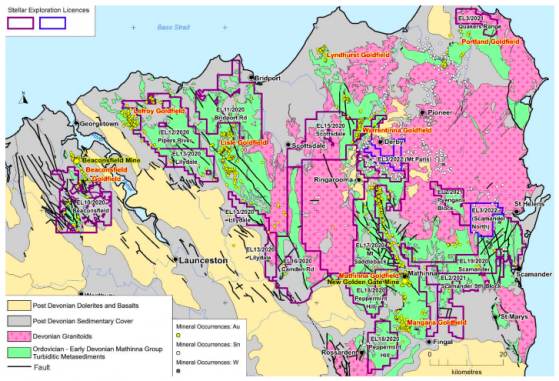Stellar Resources Ltd (ASX:SRZ) has added a combined 97 square kilometres of ground prospective for lithium, tin and base metals in the Mt Paris and Scamander North areas of Northeast Tasmania through a newly-granted licence secured by wholly-owned subsidiary Tarcoola Iron Pty Ltd.
Exploration Licence EL3/2022 has raised Stellar’s licences in northeast Tasmania to 12, covering a total of 2,212 square kilometres and which are prospective for gold, tin and lithium mineralisation.
“The grant of EL3/2022 adds to Stellar’s large tenement holding in Northeast Tasmania and importantly, hosts potential for lithium, tin and base metal mineralisation associated with fractioned granite intrusives,” Stellar executive director Gary Fietz said.
“This enhances Stellar’s commodity mix in Tasmania on top of its flagship Heemskirk Tin Project and Victorian-style gold exploration targets in Northeast Tasmania.”
Stellar’s tenement holdings at NE Tasmania. Recently granted EL3/2022 Mt Paris Block and Scamander North Block highlighted in blue.
Mt Paris block
Prospective for lithium and tin, the 38 square-kilometre Mt Paris EL3/2022 block covers the fractionated Mount Paris S-type granite, equivalent to the Lottah Granite, which, at 0.02% to 0.1% Li2O, contains the highest levels of lithium recorded anywhere in Tasmania, and hosts the historic Anchor Tin Mine.
Exploration for lithium will target pegmatites near the Mt Paris Granite margins, where there is the possibility of elevated concentrations of lithium occurring.
The EL3/2022 block contains eight recorded historic tin occurrences/mines and adjoins Tin One Resources Corp’s EL10/2019 to the south and Yunnan Tin Australia Pty Ltd’s EL17/2017 to the east. Both of these adjoining licences contain extensive historical tin mining occurrences, including the Anchor Tin Mine.
The northern part of the Mt Paris Granite has seen little modern exploration, and as such, few samples are available despite the presence of a significant body of alkali granite considered prospective for tin and lithium mineralisation.
Limited stream sediment samples from the southern part of the granite have been recorded, with values up to 1,000 parts per million (ppm), highlighting the potential for tin mineralisation. Additional anomalous stream sediment samples up to 9,400 ppm tin and 1,220 ppm lithium have been recorded within its borders held by third parties.
Scamander North block
Highly prospective for tin and base metal mineralisation, the 58 square-kilometre EL3/2022 block covers partly exposed, late-stage, Constables Creek fractionated alkali granite occurring at the margins of the extensive Mt Pearson Granite.
The block contains seven recorded alluvial tin mining occurrences/mines, of which the hard-rock source appears to not have been investigated by previous explorers.
Anomalous tin in stream sediment sample results of up to 9,300 ppm tin have been reported around alluvial tin fields in the EL3/2022 block and up to 12,000 ppm tin in the adjoining EL19/2020, highlighting the potential for tin mineralisation within both blocks.
Anomalous tin, tungsten, copper, lead, zinc, arsenic and silver in rock chip sample results of up to 1,000ppm tin in the EL3/2022 block and up to 39,500ppm tin in adjoining EL19/2020 highlights the potential for tin, tungsten and base metal deposits in the zoned mineral system within EL19/2020 and at the margins of this partially exposed alkali granite.
Significant historic exploration for tin and base metals has been undertaken at the adjoining EL19/2020, including extensive soil sampling, stream sediment sampling and drilling defining areas of anomalous tin, zinc, copper, silver and lead mineralisation northwest and southeast along strike of the Great Pyramid mine within RL 2/2009 held by Tin One Resources Corp.
The Great Pyramid Tin Mine operated between 1928 and 1936, with 336 tonnes of ore mined at an average recovered grade of 0.88% tin, implying an average grade of 1.5% tin.
Work plan
EL3/2022 Mt Paris Block and Scamander North block areas showing geology and mineral occurrences.
An initial work program within the EL3/2022 Mt Paris block will be undertaken in the first quarter of 2023, focused on identifying lithium and tin targets via mapping, rock chip and stream sediment sampling, in particular searching for pegmatites which may occur near the Mt Paris Granite Margins.
Exploration within the EL3/2022 North Scamander block will be integrated with exploration being undertaken on Stellar’s Scamander EL19/2020, primarily focused on tin and base metals.
Read more on Proactive Investors AU
